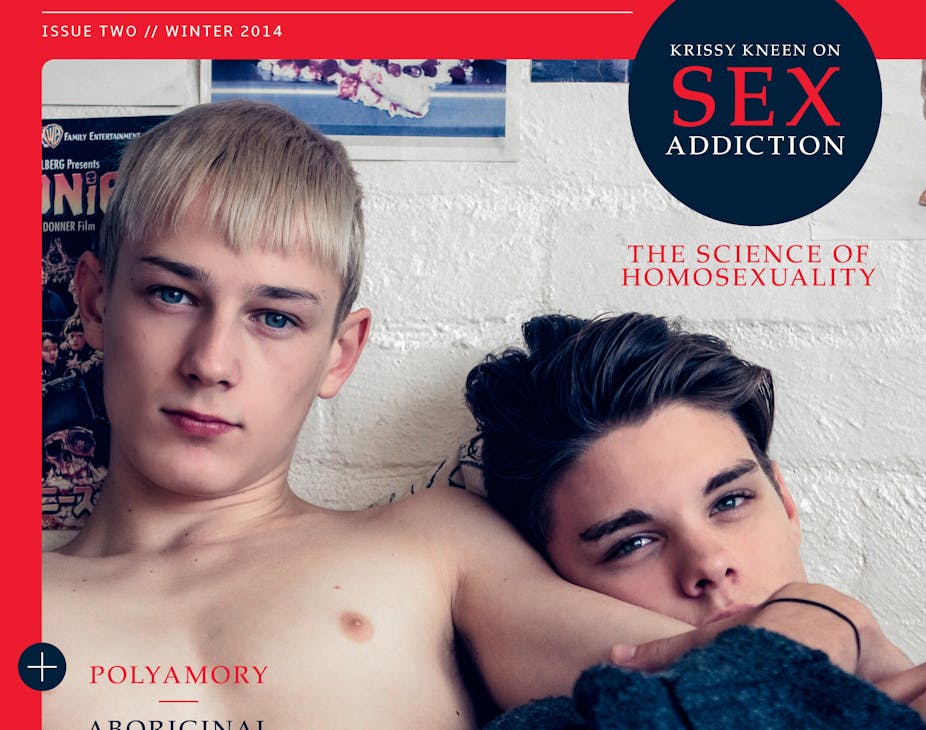When a Google search can summon any image you like online, it seems anachronistic to hear of a print publication supposedly encountering distribution problems on the basis of its content. Yet that’s just what’s happened to Archer, a glossy magazine launched last year that describes itself as “the Australian journal of sexual diversity”.
Archer’s editor and publisher, Amy Middleton, last week told the magazine’s readers that she’d received a call from her distributor, Integrated Publication Solutions (IPS), reporting that some newsagents “deemed Archer inappropriate for sale”.
The first issue, in November last year, included a bold meditation on desire and the erotic beauty of youth by author Christos Tsoilkas. It would have been a coup for the first edition of any magazine but there have been surprisingly few comments on the essay despite its celebrated author and the sensitivity of its subject matter.
Tsiolkas’ essay may get more attention now that the second edition of Archer has allegedly been removed from some newsagency shelves.
According to Middleton, retailers “advised that future issues should be ‘bagged’ (wrapped in plastic), rather than open to viewing by the public”. In a Melbourne suburban newsagent, a friend of Middleton’s found Archer had been “hidden in a drawer, restricted from view due to its content”.
On the cover of the second edition of Archer is an intimate image of two young men from a photo essay that explores themes of youthful innocence and sharehouse living. An advertisement inside includes a frontal nude image of transgender performer Buck Angel.
Is Archer being censored?
It’s unclear whether Archer was removed from shelves or whether some retailers refused to put the magazine out in the first place.
Censorship is the active suppression of materials that are considered offensive. Product selection is different. Retailers constantly make decisions about what they will stock from a catalogue of options. They make these selections based on what they believe customers will buy. No news agency, for example, could stock all 478 of IPS products.
With Archer, it may be that retailers declined to display a title they hadn’t requested in the first place. A thread on the Australian Newsagency Blog suggests this wouldn’t be an unusual occurrence. That is, the distributor appears to deliver unsolicited magazines to its clients all the time as a means of promoting new titles.
A newsagent, Steve, commented on this thread that he hadn’t received Archer, but even if the distributor “pushed it” on him, he wouldn’t likely display it: “not because I object to it but because I’m pretty sure I won’t be able to sell it”.
This may be a case of market prerogatives rather than censorship.
Obscene and ‘off scene’
Archer’s distribution problems draw our attention more closely to the vagaries of the market model and its informal processes of regulating visibility.
Unlike other publications that directly target a gay or lesbian demographic, for example, Archer reaches out more broadly to the concept of sexual diversity. It is a niche publication whose market niche is in fact very hard to pin down.
The first edition includes an essay on sexual labels, the queerness of heterosexuality and a memoir of gender transition. The second includes works on homosexuality and Aboriginal culture, sex workers’ rights, asexuality, polyamory and sex addiction.
Archer’s outlook could be described as “queer” inasmuch as that term describes a diverse spectrum of sexualities and sexual practices, including heterosexuality. As Middleton writes in her first editorial:
sexual diversity does not represent a niche or a minority – it represents the moments during which we’ve all questioned our identities, the times we’ve suspected we might be different.
Retailers refusing to stock Archer may not be practising censorship, but rather a more informal process of selection and taste classification. The very inability of retailers to imagine a market for a magazine of sexual diversity like this may be indicative of how un-represented its vision of sexuality actually is.
Is Archer obscene?
“Obscenity” is an ever shifting category that refers to what society deems objectionable. There is rarely a consensus on what is considered obscene.
While no official body has declared the content of Archer obscene – and it’s extremely unlikely that they will – we can speculate on what retailers might have found objectionable.
One commentator on the news agency blog wrote that Archer’s cover “does not do [the magazine] any favours. I also showed it to some of our gay customers and they ran a mile just on the front cover alone.” Images of young people in any proximity to any discussion of sexuality can become a source of anxiety.
Images of naked transgender bodies may be another, especially in light of Australian guidelines surrounding digital labiaplasty.
In the age of digital content and distribution, newsagents may be on their way to becoming a boutique industry. Yet the newsagency space remains a potent battleground in the public imagination.
For some they’re a moral marketplace of questionable images around which children and the elderly wander defencelessly. For others, they’re a phobic backwater in which everyday moral entrepreneurs threaten the representation of sexual diversity.

